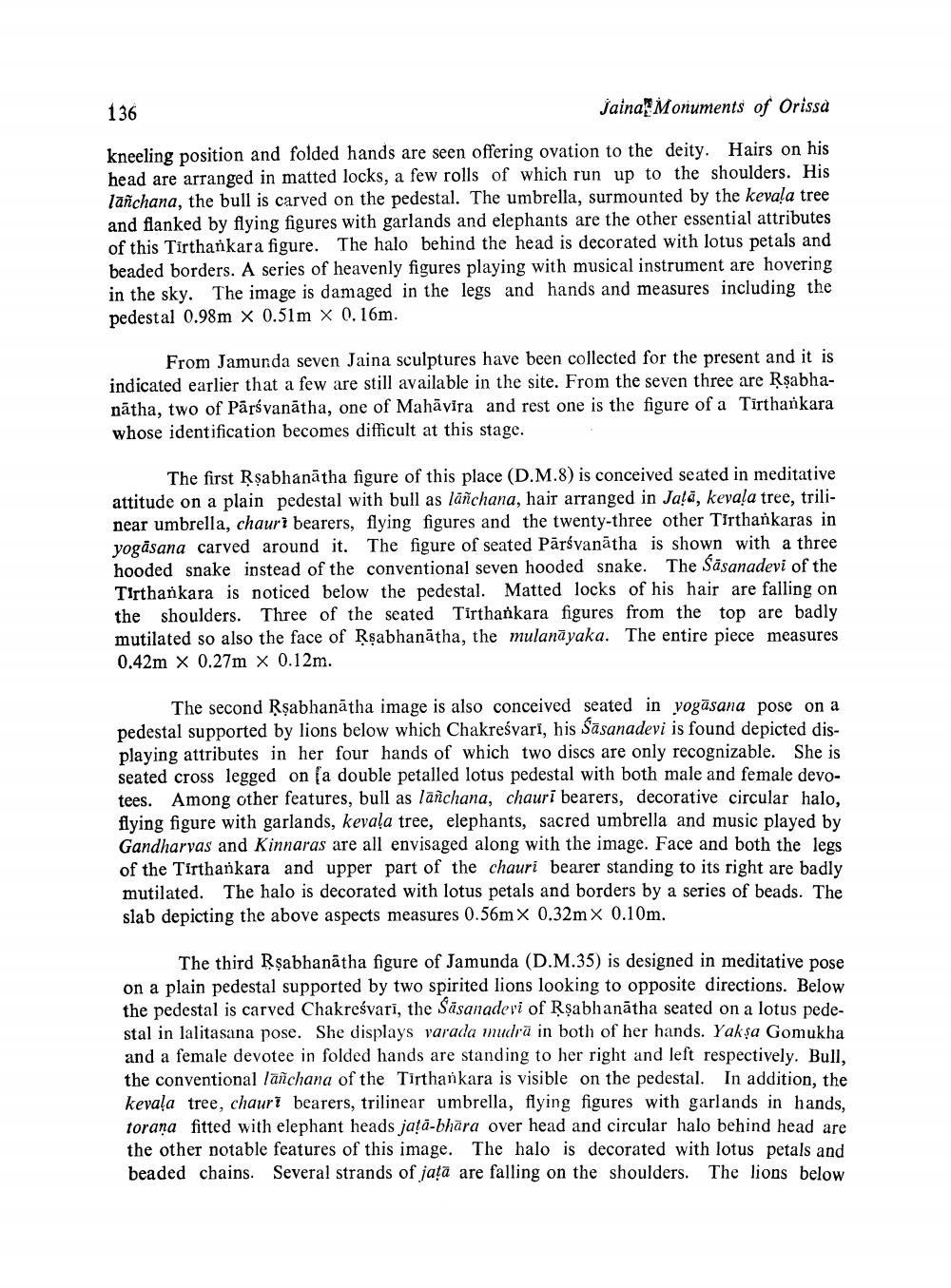________________
136
Jaina Monuments of Orissa
kneeling position and folded hands are seen offering ovation to the deity. Hairs on his head are arranged in matted locks, a few rolls of which run up to the shoulders. His lañchana, the bull is carved on the pedestal. The umbrella, surmounted by the kevala tree and flanked by flying figures with garlands and elephants are the other essential attributes of this Tirthankara figure. The halo behind the head is decorated with lotus petals and beaded borders. A series of heavenly figures playing with musical instrument are hovering in the sky. The image is damaged in the legs and hands and measures including the pedestal 0.98m x 0.51m x 0.16m.
From Jamurda seven Jaina sculptures have been collected for the present and it is indicated earlier that a few are still available in the site. From the seven three are Rşabhanātha, two of Pārsvanātha, one of Mahavira and rest one is the figure of a Tirthankara whose identification becomes difficult at this stage.
The first Rşabhanātha figure of this place (D.M.8) is conceived seated in meditative attitude on a plain pedestal with bull as lāñchana, hair arranged in Jala, kevala tree, trilinear umbrella, chaurt bearers, flying figures and the twenty-three other Tirthankaras in yogasana carved around it. The figure of seated Pārsvanātha is shown with a three hooded snake instead of the conventional seven hooded snake. The Sasanadevi of the Tirthankara is noticed below the pedestal. Matted locks of his hair are falling on the shoulders. Three of the seated Tirthankara figures from the top are badly mutilated so also the face of Rşabhanātha, the mulanāyaka. The entire piece measures 0.42m x 0.27m x 0.12m.
The second Rşabhanātha image is also conceived seated in yogāsana pose on a pedestal supported by lions below which Chakreśvari, his Sāsanadevi is found depicted displaying attributes in her four hands of which two discs are only recognizable. She is seated cross legged on (a double petalled lotus pedestal with both male and female devotees. Among other features, bull as lañchana, chauri bearers, decorative circular halo, flying figure with garlands, kevaļa tree, elephants, sacred umbrella and music played by Gandharvas and Kinnaras are all envisaged along with the image. Face and both the legs of the Tirthankara and upper part of the chauri bearer standing to its right are badly mutilated. The halo is decorated with lotus petals and borders by a series of beads. The slab depicting the above aspects measures 0.56m x 0.32m x 0.10m.
The third Rşabhanātha figure of Jamunda (D.M.35) is designed in meditative pose on a plain pedestal supported by two spirited lions looking to opposite directions. Below the pedestal is carved Chakreśvarī, the Sasanadevi of Rşabhanātha seated on a lotus pedestal in lalitasana pose. She displays varada mudra in both of her hands. Yakşa Gomukha and a female devotee in folded hands are standing to her right and left respectively. Bull, the conventional lañchana of the Tirthankara is visible on the pedestal. In addition, the kevala tree, chauri bearers, trilinear umbrella, flying figures with garlands in hands, torana fitted with elephant heads jata-bhara over head and circular halo behind head are the other notable features of this image. The halo is decorated with lotus petals and beaded chains. Several strands of jața are falling on the shoulders. The lions below




